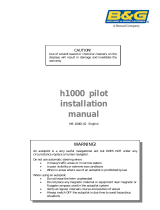
Saltwater Considerations
NOTICE
Using the boat in salt water will cause rust to develop inside of
the tilt tube, even with careful maintenance. If you install the
steering actuator on a boat used in saltwater, without regular
maintenance the boat steering will be stiff, and eventually the
steering actuator will seize. Mechanical damage to the steering
actuator caused by attempting to free a seized push rod is not
covered by the product warranty.
If your tilt tube is made of mild steel, you must perform routine
maintenance after every use, or at least twice monthly (Steering
Actuator Routine Maintenance and Storage Information,
page 7).
Many motor manufacturers offer a stainless steel tilt tube option.
If your motor has a mild-steel tilt tube and you plan to use the
boat in salt water, you should replace the stock tilt tube with the
stainless steel tilt tube if the option is available. You can contact
your local dealer or motor manufacturer for more details.
Even when installing the steering actuator in a stainless steel tilt
tube, if you use your boat in saltwater, you should perform the
routine maintenance at least twice per year (Steering Actuator
Routine Maintenance and Storage Information, page 7).
Throttle Actuator Mounting and Connection Considerations
• The throttle actuator mounts inside the motor housing and
connects to the throttle to control the speed.
• You should follow the instructions provided with the throttle
actuator for assembly and mounting details.
• You must install the throttle actuator before permanently
mounting the ECU.
• You cannot extend the cable that connects the throttle
actuator to the ECU.
NMEA 2000 Connection Considerations
• The CCU and the helm control must connect to a NMEA
2000 network.
• If your boat does not already have a NMEA 2000 network,
one can be built using the included NMEA 2000 cables and
connectors (Building a Basic NMEA 2000 Network for the
Autopilot System, page 6).
• To use the advanced features of the autopilot, optional
NMEA 2000 devices, such as a wind sensor, a water-speed
sensor, or a GPS device, can be connected to the NMEA
2000 network.
Installation Procedures
CAUTION
Always wear safety goggles, ear protection, and a dust mask
when drilling, cutting, or sanding.
NOTICE
When drilling or cutting, always check what is on the opposite
side of the surface.
After you have planned the autopilot installation on your boat
and satisfied all of the mounting and wiring considerations for
your particular installation, you can begin mounting and
connecting the components.
Helm Control Installation
A dedicated helm control is not included in all autopilot
packages. If you install the autopilot without a dedicated helm
control, the autopilot CCU must be connected to the same
NMEA 2000 network as a compatible Garmin chartplotter to
configure and control the autopilot system.
Detailed mounting instructions are included in the helm control
box.
Mounting the CCU
1
Determine the mounting location.
2
Using the CCU as a template, mark the two pilot hole
locations on the mounting surface.
3
Using a 3 mm (
1
/
8
in.) bit, drill the pilot holes.
4
Use the included screws to attach the CCU to the mounting
surface.
NOTE: If you use mounting hardware other than the provided
screws, the hardware must be quality stainless or brass
material to avoid magnetic interference with the CCU.
Test any mounting hardware with a handheld compass to
make sure no magnetic fields are present in the hardware.
ECU Installation
Mounting the ECU
Before you can mount the ECU, you must select a location and
determine the correct mounting hardware (ECU Mounting and
Connection Considerations, page 2).
1
Hold the ECU in the intended mounting location and mark the
locations of the mounting holes on the mounting surface,
using the ECU as a template.
2
Using a drill bit appropriate for the mounting surface and
selected mounting hardware, drill the four holes through the
mounting surface.
3
Secure the ECU to the mounting surface using the selected
mounting hardware.
Connecting the ECU to Power
WARNING
When connecting the power cable, do not remove the in-line
fuse holder. To prevent the possibility of injury or product
damage caused by fire or overheating, the appropriate fuse
must be in place as indicated in the product specifications. In
addition, connecting the power cable without the appropriate
fuse in place voids the product warranty.
You should connect the ECU power cable directly to the boat
battery, if possible. Although it is not recommended, if you
connect the power cable to a terminal block or other source, you
must connect it through a 40 A fuse.
If you plan to route the ECU power through a breaker or a switch
near the helm, you should consider using an appropriately sized
relay and control wire instead of extending the ECU power
cable.
1
Route the connector-terminated end of the ECU power cable
to the ECU, but do not connect it to the ECU.
2
Route the bare-wire end of the ECU power cable to the boat
battery.
If the wire is not long enough, it can be extended (Power
Cable Extensions, page 4).
3
Connect the black wire (-) to the negative (-) terminal of the
battery, and connect the red wire (+) to the positive (+)
terminal of the battery.
4
After you install all of the other autopilot components,
connect the power cable to the ECU.
NOTICE
You should apply dielectric grease to the pin holes on the
cable connector to prevent corrosion, especially if you are
using the autopilot system in saltwater.
Additional Grounding Consideration
This device should not need additional chassis grounding in
most installation situations. If you experience interference, you
can use the grounding screw on the housing to connect the
device to the water ground of the boat to help avoid the
interference.
3










